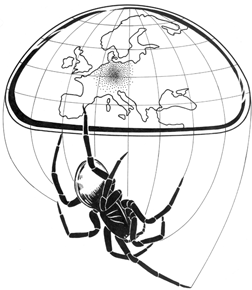Arachnologische Mitteilungen
LISTE ALLER ARTIKEL
Morphological separation of the Central European Trochosa females (Araneae, Lycosidae)
Morphologische Unterscheidung der der mitteleuropäischen Trochosa-Weibchen (Araneae, Lycosidae)
morphometry; spiders; taxonomy
Abstract
Adult females of the five Central European wolf spiders Trochosa hispanica Simon, 1870, T. robusta (Simon, 1876), T. ruricola (DeGeer, 1778), T. spinipalpis (F.O.P.-Cambridge, 1895), and T. terricola Thorell, 1856 were morphologically analysed. We defined sets of continuous and binary (presence/absence) variables. Continuous data of various epigynal and carapace dimensions were subjected to Principal Component Analysis (PCA). Using the PC loadings each individual was plotted along the PC axis in order to find gaps(overlaps between the species. The binary data sets were subjected to Hierarchical Cluster Analysis (HCA) in order to find characters that clearly separate the five Trochosa species. Using PCA only individuals of T.robusta and T.ruricola and of T.robusta and T.hispanica could be separated from each other. Using HCA all five species could clearly be separated by epigynal and vulval characteristics."
Zum Vorkommen von Atypus affinis und Atypus piceus (Araneae: Atypidae) auf einer Sukzessionsfläche im flurbereinigten Rebgelände des Kaiserstuhls
The distribution of syntopic Atypus affinis and Atypus piceus (Araneae: Atypidae) in a succession area of vine-yard slopes in the Kaiserstuhl (south-western Germany)
fire management; land consolidation; recolonisation; succession; syntopy; temporal isolation
Abstract
The orthognath spiders Atypus affinis Eichwald, 1830 and A. piceus (Sulzer, 1776) are morphologically and biologically similar. One of the few sites where both species live syntopically is located in the Kaiserstuhl Mountains in south-west Germany. This has been shown in a continuous 22 year long-term study of the recolonisation of vineyard slopes after large-scale land consolidation. The males of both species differ in size and the annual timing of their surface activity. The recolonisation history of A. affinis and A. piceus was recorded. As typical K-strategists, their population sizes have increased slowly. Today they are still growing. Atypus species can be used as models regarding problems of nature conservation, since they are particularly endangered by large-scale and catastrophic habitat changes as a result of their long generation time. In the Kaiserstuhl such catastrophic events could include fire management, which has recently been permitted again for the preservation of the slopes.
Drassodes lapidosus und Drassodes cupreus (Araneae: Gnaphosidae) – eine unendliche Geschichte
Drassodes lapidosus and Drassodes cupreus (Araneae: Gnaphosidae) – a never-ending discussion
morphological characters; spiders; taxonomy
Abstract
According to Platnick (2006) the taxa Drassodes lapidosus (Walckenaer, 1802), the type species of the genus Drassodes (Westring, 1851), and Drassodes cupreus (Blackwall, 1834) are two valid species. However Grimm (1985) merged them into one taxon. Different taxonomists have separated these species by the positions of the teeth in the frontal margin of the chelicerae and by the proportions of the palpal segments in males. Females are separated by the proportions of different features in the epigyne. The altitude at which they occur is used for separation, too. The aim of this paper is to discuss whether these characteristics really allow the separation of these two taxa. In order to solve these taxonomical problem, 116 male and 108 female specimens from Central Europe were examined. The variation of the mentioned characters is shown. Spearman's rho correlations and factor analyses are presented. The results show that there are transitions between the two taxa D. lapidosus and D. cupreus and, thus, they cannot be separated using the diagnostic features currently available.
Sven Almquist (2005): Swedish Araneae, part 1 – families Atypidae to Hahniidae (Linyphiidae excluded)
Sven Almquist (2005): Swedish Araneae, part 1 – families Atypidae to Hahniidae (Linyphiidae excluded)
book review
Abstract
book review: Sven Almquist (2005): Swedish Araneae, part 1 – families Atypidae to Hahniidae (Linyphiidae excluded)
Spinnen aus Baumkronen-Klopfproben (Arachnida: Araneae), mit Anmerkungen zu Cinetata gradata (Linyphiidae) und Theridion boesenbergi (Theridiidae)
Spiders from branch-beating samples in tree crowns (Arachnida: Araneae), with remarks on Cinetata gradata (Linyphiidae) and Theridion boesenbergi (Theridiidae)
arboreal spiders; Bavaria; canopy; Douglas-fir; Germany; spruce; winter activity
Abstract
In winter 2000/01 and in June 2001 branch-beating methods were used for sampling spiders in canopies of spruce (Picea abies) and Douglas-fir (Pseudotsuga menziesii) in SW-Bavaria (Germany). Differences in spider assemblages between the two species are discussed with particular emphasis on the dominant species and taxa. For the rare species Theridion boesenbergi Strand, 1904 remarks on their occurence in Bavaria, Germany and Europe are given. For Cinetata gradata (Simon, 1881) we present an update to the entire known distribution including a new map. For both species new records are specified and discussed concerning habitat preference, phenology and distribution. Both species seem to be obligate tree colonisers, C. gradata primarily in the canopy stratum. Adults of C. gradata are to be found during all months of the year; T. boesenbergi exhibits an abundance peak in June, males are known to occur from May to August and females the whole year round. The distribution of both species is restricted to Europe, excluding the northern and western parts (Arctic and Atlantic climate) and the Mediterranean zone.
Further faunistic notes on Cozyptila and Xysticus from Turkey (Araneae, Thomisidae)
Further faunistic notes on Cozyptila and Xysticus from Turkey (Araneae, Thomisidae)
Caucasus; crab spiders; faunistics; Minor Asia; new synonymy
Abstract
Nine recently described or poorly known species of the thomisid genera Cozyptila Lehtinen & Marusik, 2005 and Xysticus C.L. Koch, 1835 are reported from Turkey. Five species, Cozyptila blackwalli (Simon, 1875), C. thaleri Marusik & Kovblyuk, 2005, Xysticus bacurianensis Mcheidze, 1971, X. thessalicoides Wunderlich, 1995 and X. xerodermus Strand, 1913 are new records for the Turkish spider fauna. Two species, X. bacurianensis and X. xerodermus are illustrated and a distribution map is provided for the former. A few additional records are given for Greece and the Caucasian countries, of which, of which X. bacurianensis is new for Azerbaijan.
Caucasian Spiders – a faunistic database on the spiders of the Caucasus – caucasus-spiders.info
Caucasian Spiders – a faunistic database on the spiders of the Caucasus – caucasus-spiders.info
url information
Abstract
url information


